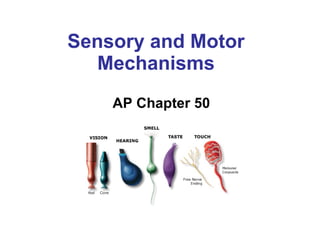
Ap chap 50 sensory perception and motor action
- 1. Sensory and Motor Mechanisms AP Chapter 50
- 10. Hearing http://msjensen.cehd.umn.edu/1135/Links/Animations/Flash/0019-swf_effect_of_soun.swf The three small bones transmit vibrations To the inner ear which contains fluid-filled canals.
- 11. Air pressure vibrates fluid in canals which vibrate the basilar membrane, bending the hairs of its receptor cells against the tectorial membrane which opens ion channels and allows K+ to enter the cells and cause a depolarization and releases neurotransmitters to continue to the auditory nerve to the brain.
- 12. Frequency (pitch) determined by areas of basilar membrane that vibrate at different frequencies; areas are thick and thin
- 20. Copyright © 2002 Pearson Education, Inc., publishing as Benjamin Cummings Fig. 49.24
- 24. Light hits the retina and then comes back through the cells to the optic nerve.
- 25. Photoreceptors
- 26. Rods and cones have visual pigments embedded in a stack of folded membranes or disks in each cell. Retinal is the light-absorbing pigment and is bonded to a membrane protein – opsin . Combo – rhodopsin.
- 27. When retinal absorbs light, it changes shape and separates from opsin. In the dark, the retinal is converted back to its original shape.
- 29. Notice in the light, the Na + channels are closed.
- 32. Copyright © 2002 Pearson Education, Inc., publishing as Benjamin Cummings Fig. 49.24
- 34. Locomotion and muscle action
- 35. How the muscle cell is organized Animations This is ONE muscle cell, called a muscle fiber. for energy The muscle fiber (cell) is made up of many myofibrils which in turn are made up of sarcomeres, the units of contraction.
- 37. The contracting unit is the sarcomere. Fig. 50-25b TEM Thick filaments (myosin) M line Z line Z line Thin filaments (actin) Sarcomere 0.5 µm
- 38. The sliding filament model When the sarcomere contracts, the filaments slide over each other. They do not change length.
- 45. Mechanism of Filament Sliding at the Neuromuscular Junction Mechanism of Filament Sliding
- 49. Protein models of muscle action
Editor's Notes
- Figure 50.25 The structure of skeletal muscle